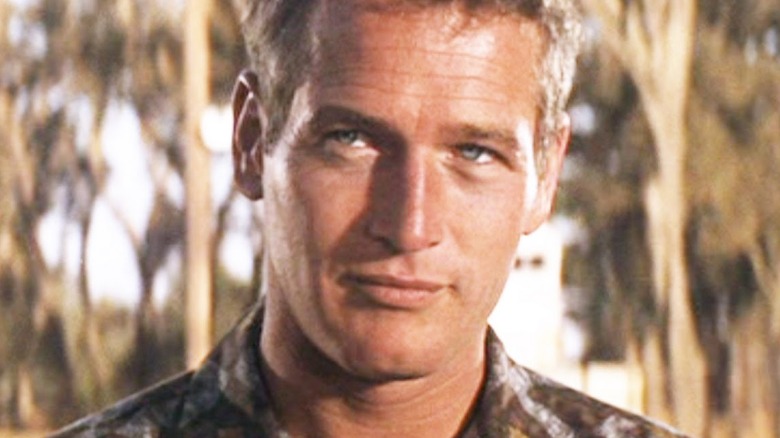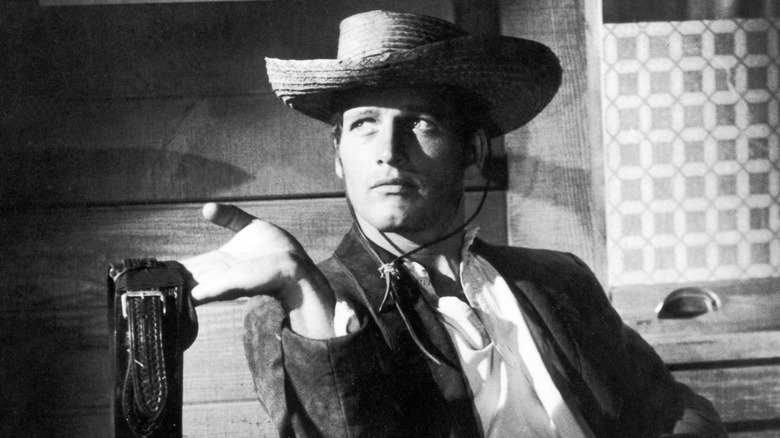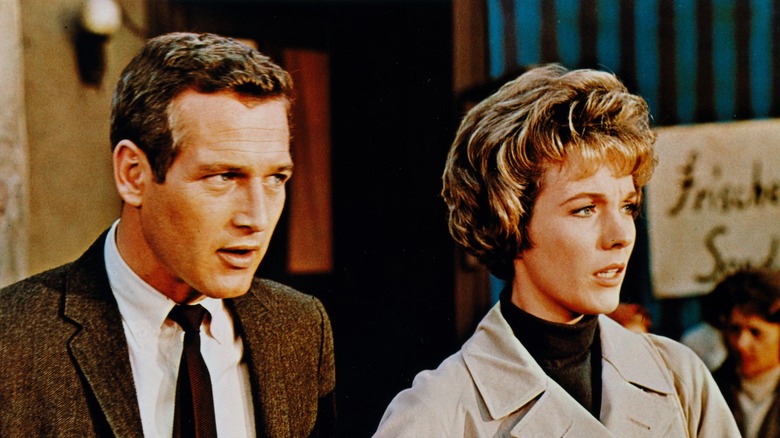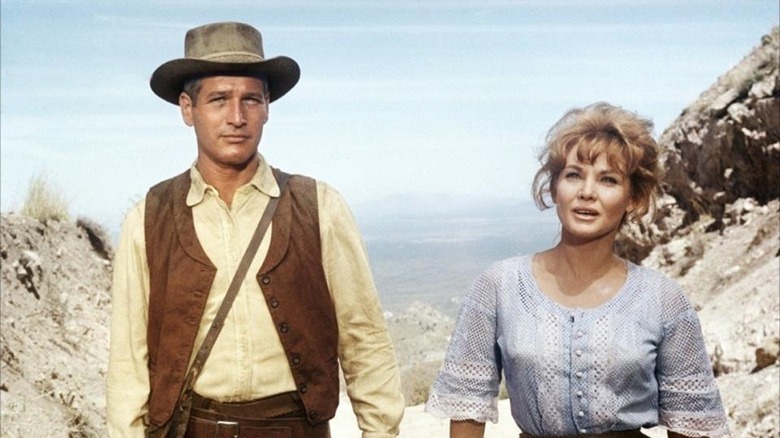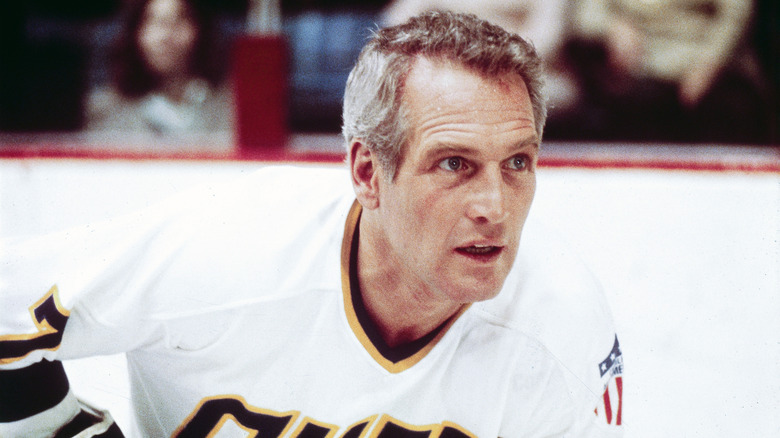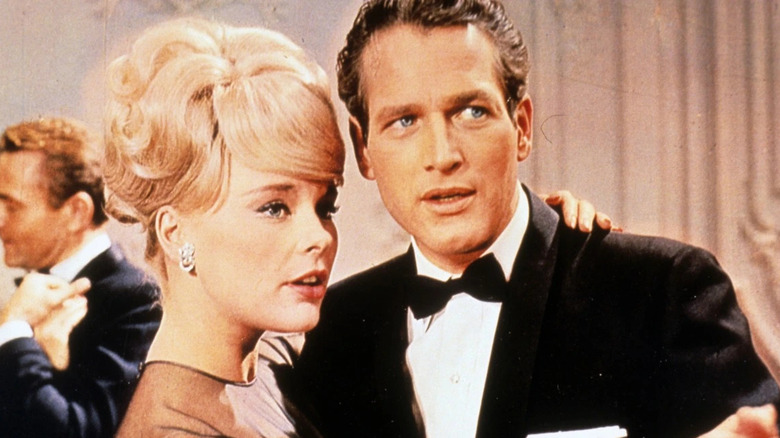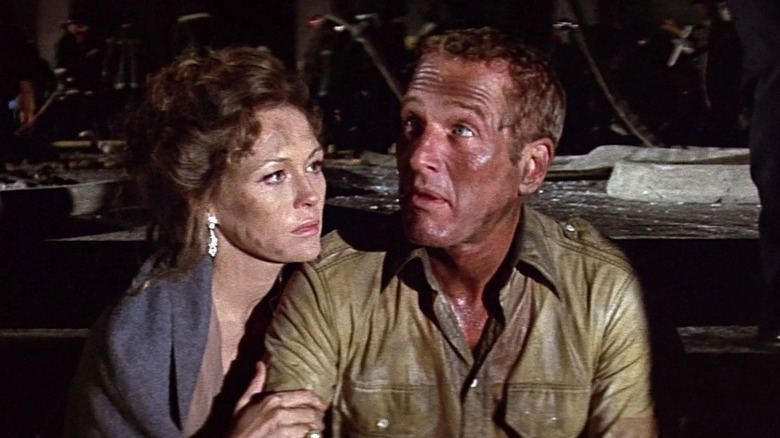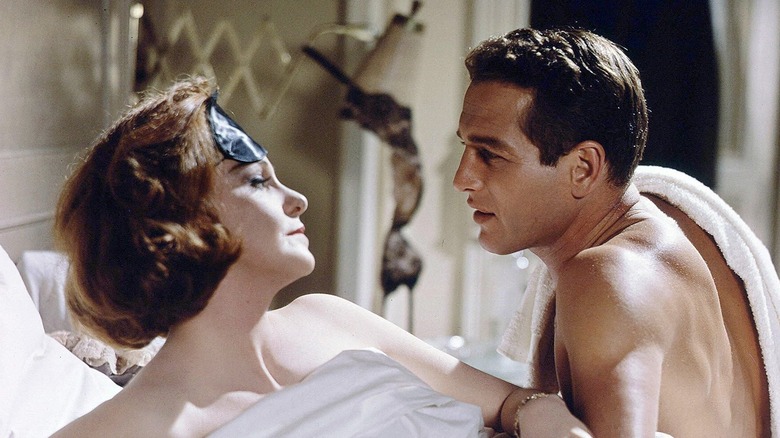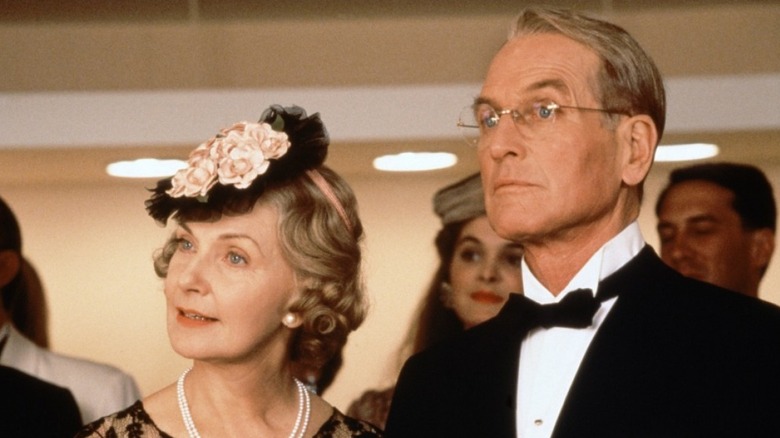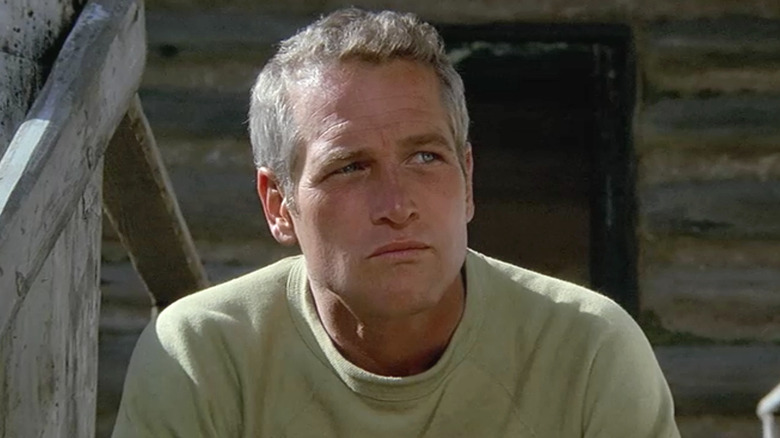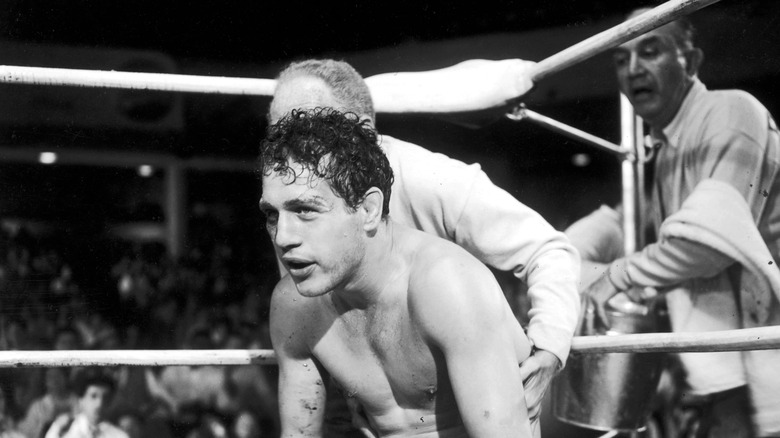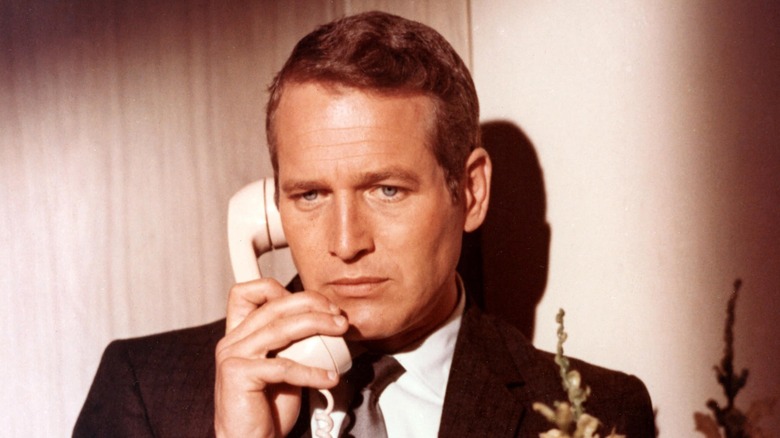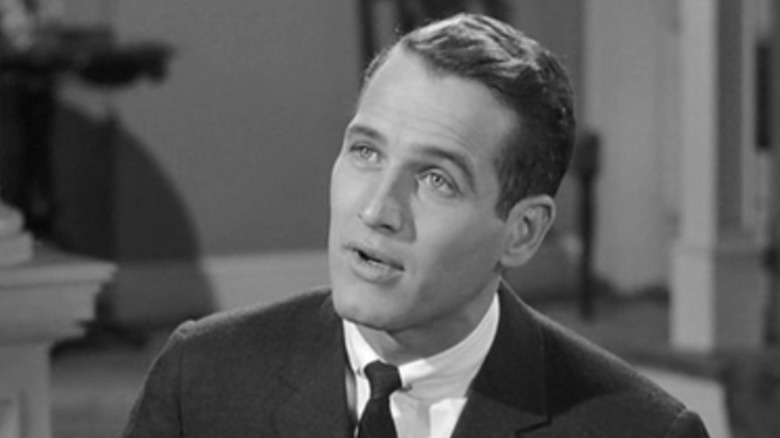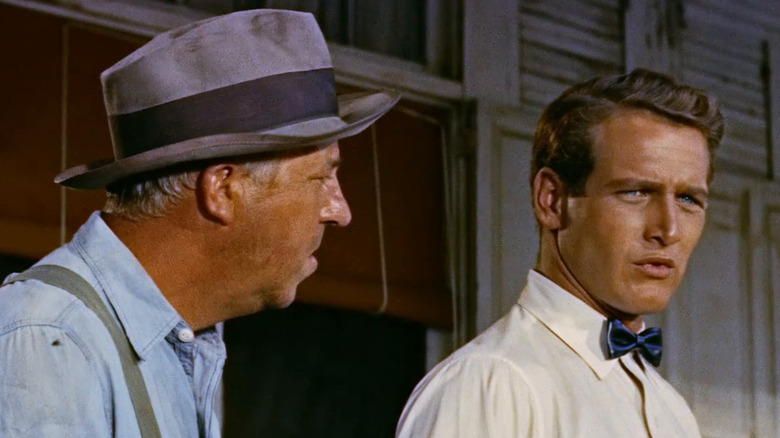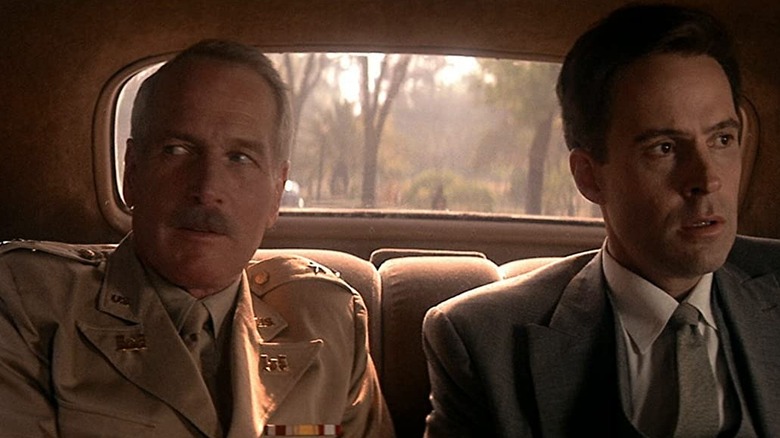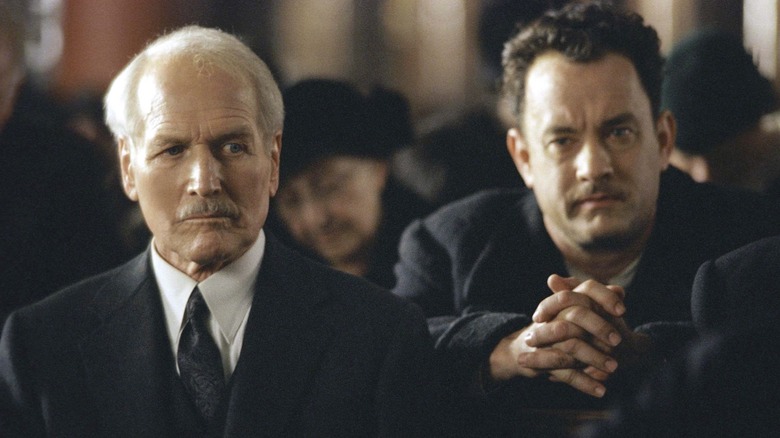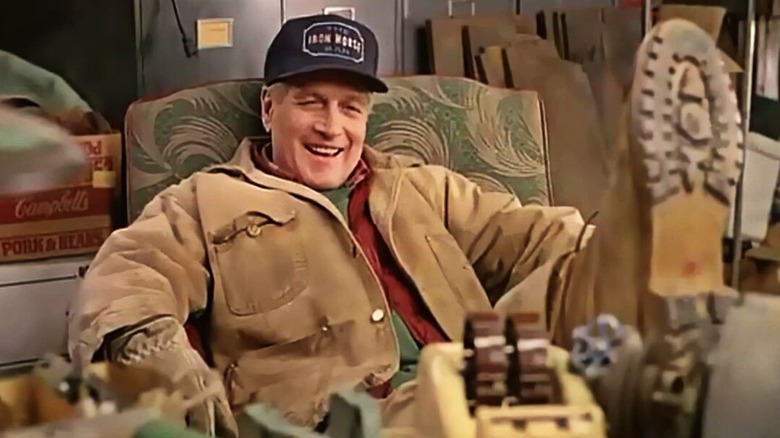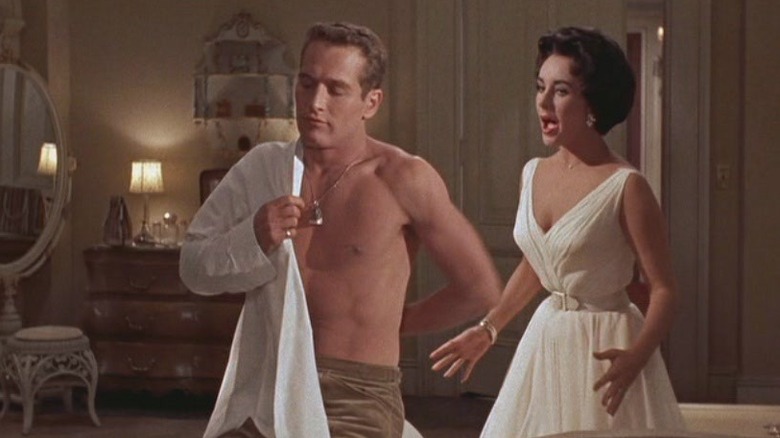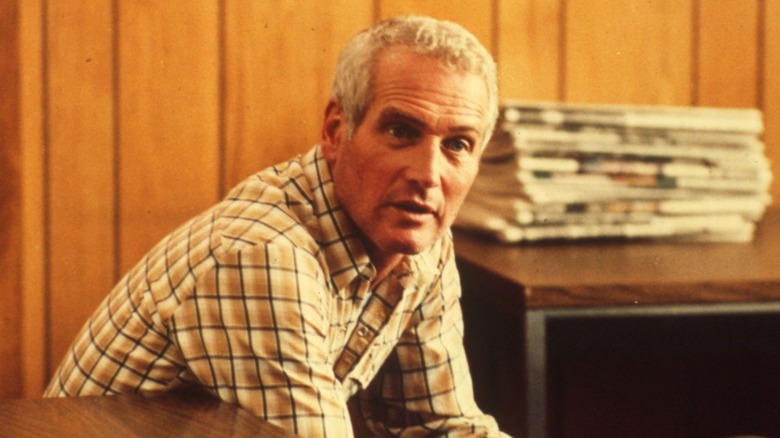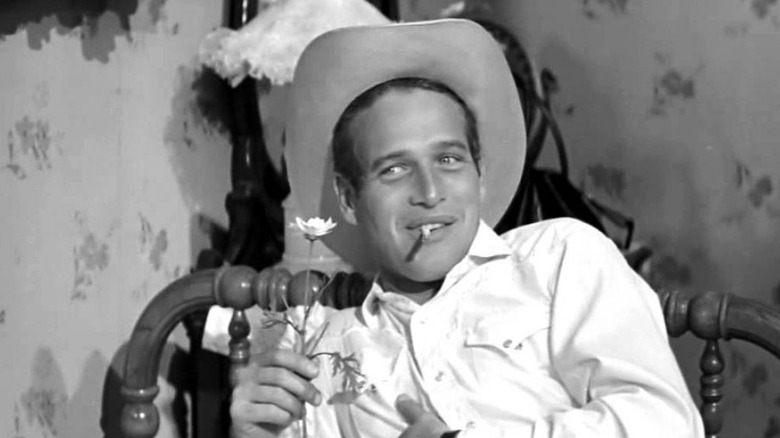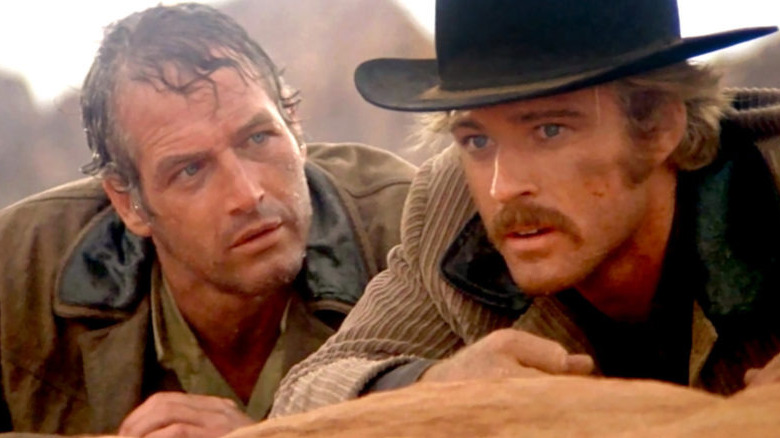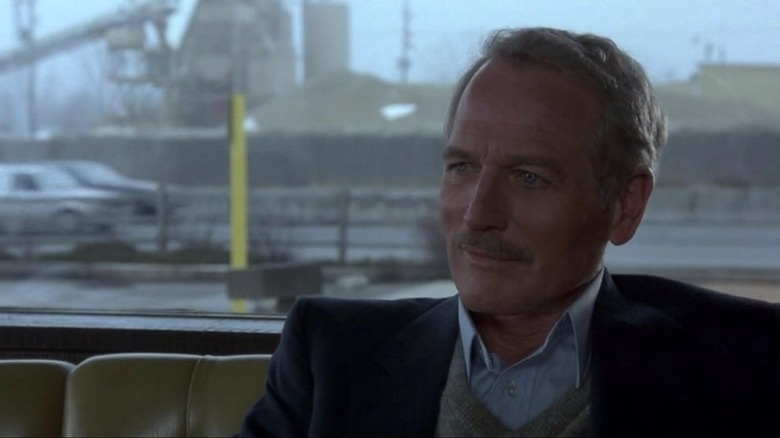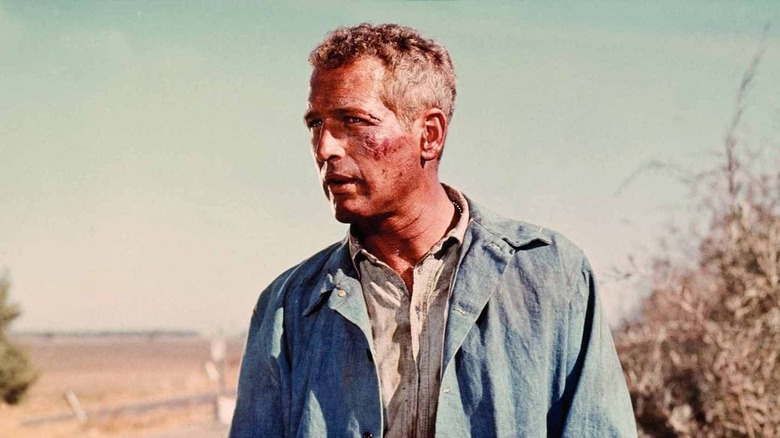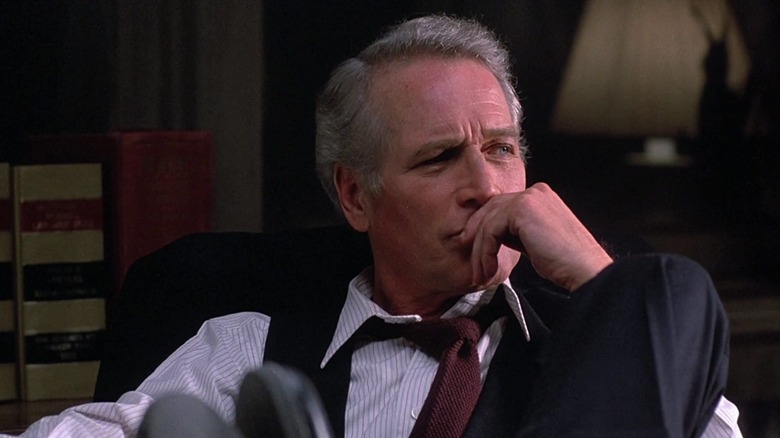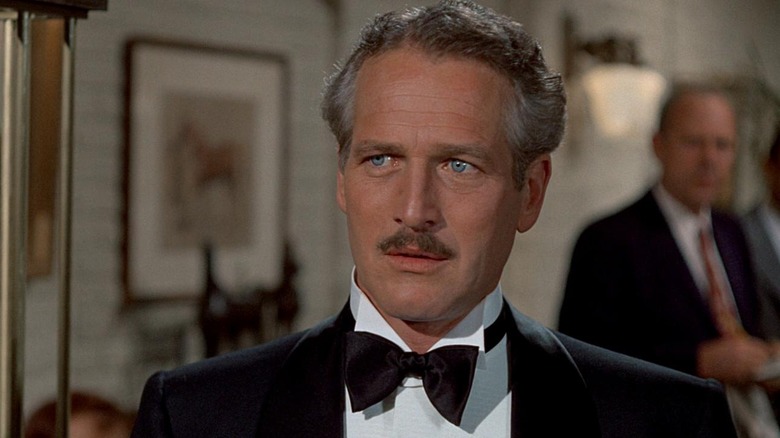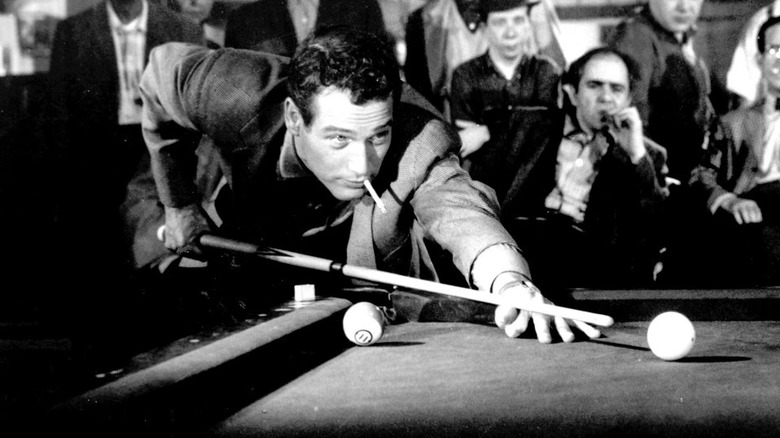25 Greatest Paul Newman Movies Ranked Worst To Best
A true Hollywood icon, Paul Newman's career spanned from the early 1950s to his eventual retirement in 2007. He died the following year at the age of 83. With his icy blue gaze and easygoing charisma, he brought an enormous amount of emotional depth and vulnerability to his many roles, from directionless men bucking against authority to morally conflicted characters stumbling towards redemption. He won an Oscar for best actor in 1987 and was nominated on nine other occasions, making him one of the most celebrated actors in the history of the Academy Awards. Audiences also responded favorably to Newman's well-honed acting talents, with many of his films earning impressive box office totals and continuing to endure the test of time.
Here are the 25 best movies starring Paul Newman, from postmodern Westerns that subverted audience expectations and taut legal thrillers that gripped viewers, to outrageous comedies that still hold up to this day.
25. The Left Handed Gun (1958)
Paul Newman's first feature length Western, a genre that he became closely associated with over the course of his career, 1958's "The Left Handed Gun" is a must-see for fans of the actor. Newman stars as legendary outlaw Billy the Kid in this film, helmed by Arthur Penn in his directorial debut (he went on to direct classics like "Bonnie and Clyde" and "Alice's Restaurant"). Just as Penn depicted Bonnie and Clyde as counter-culture figures, "The Left Handed Gun" made Billy the Kid something of a misunderstood gunslinger.
The movie sees a young William Bonney given a home and work by a cattle rancher named John Tunstall, only for Tunstall to be brutally murdered by his rivals. Seeking revenge, Bonney becomes labeled a murderous outlaw, with his old friend Pat Garrett out to bring him down for good. Though initially unsuccessful in the United States ("At the time of its release, the film was deemed too psychological and disturbing," said veteran film critic Emanuel Levy), "The Left Handed Gun" would find greater success overseas, with its reputation improving domestically over time. It's now known as an important entry in both Newman and Penn's careers.
24. Torn Curtain (1966)
Fresh off a run of critically and commercially successful films, Paul Newman teamed with legendary director Alfred Hitchcock for the 1966 film "Torn Curtain." Completing the main ensemble for this Cold War espionage thriller was Julie Andrews, who was also a hot property in Hollywood having fronted "Mary Poppins" and "The Sound of Music." "Torn Curtain" stars Newman and Andrews as Michael Armstrong and Sarah Sherman, an engaged couple. Armstrong is poised to defect to the Soviet Union in East Germany.
Hitchcock would personally not appreciate Newman's style of method acting, writing disparagingly about his use of the technique on "Torn Curtain" in a private letter to actor Joan Crawford. While "Torn Curtain" received a mixed critical and audience reception upon its release, the film's reputation has improved over the years and it is now considered an underrated movie in Hitchcock's enduring body of work. With plenty of twists and turns anchored by a strong pair of leads, "Torn Curtain" remains a sleeper hit for Hitchcock and the movie's two stars.
23. Hombre (1967)
After working well together on a string of well-received movies, Paul Newman and filmmaker Martin Ritt reunited for the 1967 revisionist Western "Hombre," with Ritt directing and producing the project. Based on the 1961 novel of the same name by Elmore Leonard, Newman stars as a gunslinger named John Russell, who was raised by the Apache. He faces constant discrimination as a result of his upbringing. When Russell takes a stagecoach ride that is targeted by frontier outlaws, he is forced to go on the offensive.
Critics praised Ritt's directorial work on "Hombre," along with Newman's understated, withdrawn performance as the morally conflicted Russell. Newman is backed by an impressive ensemble cast in this film, which celebrates and subverts established tropes of the Western genre. "Hombre" would be the final time Ritt directed Newman, though the two considered working together on an adaptation of "First Blood" before the project changed hands and made Sylvester Stallone an action icon.
22. Slap Shot (1977)
In a change of pace from his more serious roles, Paul Newman starred in the 1977 sports comedy "Slap Shot" as minor league ice hockey player and coach Reggie Dunlop. Set in a fictional steel milling town in Pennsylvania, the film follows the Charlestown Chiefs, whose entertaining exploits help the locals deal with the steadily declining livelihood of their community. And while the Chiefs' violent, unorthodox style of play makes them popular with the fans, it complicates their long-term prospects and standing in the league. Newman would later refer to Reggie Dunlop as one of his favorite all-time characters.
Directed by George Roy Hill, "Slap Shot" brought plenty of vulgar, rowdy humor to the screen, with Newman more than holding his own amidst all the comedic chaos. He landed the role partly because he was a competent skater. "Al Pacino was originally up for the role of Reggie Dunlop, but was offended that the director seemed more concerned with his agility on the ice than his acting chops," Rolling Stone's Dan Epstein revealed. "Nick Nolte, Harrison Ford, John Travolta, Tommy Lee Jones, Kurt Russell and Richard Gere also auditioned for various parts in the film; none of them skated well enough to qualify." The movie has grown to become something of a cult classic, with some reviewers placing it among the best hockey movies ever made, comical or otherwise.
21. The Prize (1963)
Irving Wallace's popular 1962 novel "The Prize" was adapted into a feature film of the same name in 1963, starring Paul Newman as influential young writer Andrew Craig. While Craig's work has earned him the Nobel Prize in Literature, he is more interested in carousing Stockholm (where the award ceremony is being held) than receiving the prestigious recognition itself. However, the event and one of its honorees are targeted by East German operatives as the Cold War looms over the proceedings.
Directed by Mark Robson, "The Prize" is a cinematic fusion of romantic comedy and international intrigue that gives Newman plenty of room for a more nuanced performance. For his part, Newman was more interested in the script's depiction of Craig than the novel's popularity. It could have turned into a lightweight project, but Newman grounded his performance in some genuine character conflict, much to the movie's benefit.
20. The Towering Inferno (1974)
One of the highest-earning movies at the 1974 box office, "The Towering Inferno" was directed by John Guillermin and produced by disaster movie maestro Irwin Allen. Based on the novels "The Tower" by Richard Martin Stern and "The Glass Inferno" by Thomas N. Scortia and Frank M. Robinson, the movie sees a skyscraper endure a rapidly growing electrical fire. Newman stars as the skyscraper's architect Doug Roberts, who realizes faulty wiring endangers a party commemorating the building's grand opening prior to a blaze breaking out.
Newman and Steve McQueen lead an all-star cast here. The movie has Roberts trapped in the skyscraper during the fire, with McQueen starring as intrepid firefighter Michael O'Halloran. Praised for its entertaining sense of spectacle and high level of technical achievement, "The Towering Inferno" was nominated for eight Academy Awards, including best picture. Looking back at the production, Guillermin would later remark that Newman's character was a thankless one but that the actor helped elevate the role considerably.
19. Sweet Bird of Youth (1962)
After starring in the film adaptation of Tennessee Williams' award-winning play "Cat on a Hot Tin Roof," Paul Newman starred in another adapted work from the celebrated playwright, 1962's "Sweet Bird of Youth." Newman plays a young drifter named Chance Wayne who enters a romance with an older movie star named Alexandra del Lago to help aid his Hollywood ambitions. The couple returns to Wayne's Mississippi hometown, with tension between them and Wayne's reputation in town threatening to derail their lives.
"Sweet Bird of Youth" was written and directed by Richard Brooks, who previously helmed Newman in the "Cat on a Hot Tin Roof" adaptation. The two continued to work well together here, joined by an impressive ensemble cast, including Geraldine Page as Alexandra del Lago and Ed Begley as Tom Finley, the town's most powerful figure. For his role as Wayne, Newman effectively found the balance between capturing the character's more underhanded sensibilities while bringing plenty of charisma and sympathy to him.
18. Mr. & Mrs. Bridge (1990)
Paul Newman married his real-life wife Joanne Woodward after starring with her in the 1958 film "The Long, Hot Summer." Their final feature film collaboration was 1990's "Mr. & Mrs. Bridge," based on the novel series by Evan S. Connell. Woodward had been interested in adapting the material for years, with her and Newman both taking lower salaries to help the film get made. Set in Kansas City during the 1930s and '40s, "Mr. & Mrs. Bridge" stars the two actors as Walter and India Bridge, whose conservative worldview leads them to clash with their children.
Newman portrayed the Bridge family patriarch with a cold, emotionally distant approach, while Woodward gave a more conflicted, multi-dimensional performance as India. Critics praised the couple's dynamic, with Woodward receiving particularly strong acclaim, resulting in her earning an Academy Award nomination for her role. While "Mr. & Mrs. Bridge" marked Newman and Woodward's final big screen collaboration, the two would appear together on screen one last time for the 2005 television miniseries "Empire Falls."
17. Sometimes a Great Notion (1971)
For his sophomore directorial project, Paul Newman adapted the 1964 Ken Kesey novel "Sometimes a Great Notion" into a drama of the same name. Newman also starred in the film, portraying Oregon logger Hank Stamper. Veteran actor Henry Fonda plays Hank's father Henry, and Lee Remick portrays Hank's wistful wife Viv. The Stamper family find themselves shunned by their community when they refuse to support a union strike against a logging company running the town's business.
Newman took on the directorial reins for "Sometimes a Great Notion" when he fired the original director Richard Colla after two weeks of principal photography. The movie provides a layered look at each of the Stamper family and the dynamic between them rather than veering into outright melodrama. Boasting a perfect critical score on Rotten Tomatoes, "Sometimes a Great Notion" has been praised for the meticulous craft Newman brought to his role and his work as its director.
16. Somebody Up There Likes Me (1956)
One of Paul Newman's earliest starring roles in a major feature film was portraying celebrated middleweight boxing champion Rocky Graziano in the 1956 biopic "Somebody Up There Likes Me." The movie traced Graziano's unhappy upbringing to his dishonorable discharge from the U.S. Army following his desertion to pursue a career in boxing. As Graziano finds love and attempts to embrace his fresh start as a legitimate fighter, he finds his troubled past coming back to haunt him.
Directed by Robert Wise, "Somebody Up There Like Me" was originally intended as a vehicle for James Dean before the actor's tragic demise in a road accident. With Newman replacing Dean as the pugilistic protagonist, the biopic was a critical and commercial success, earning three Academy Award nominations. "Somebody Up There Likes Me" was instrumental in catapulting Newman towards becoming a bonafide movie star as his cinematic career began to solidly take shape.
15. Harper (1966)
Paul Newman leaned into pulp neo-noir with director Jack Smight in the 1966 film "Harper," based on the crime novel "The Moving Target" by Ross Macdonald. Newman plays Lew Harper, a private investigator tasked with looking into the sudden disappearance of a multi-millionaire shortly after his arrival in Los Angeles. The movie was made as a love letter and update to the noir genre, with actor Lauren Bacall given a major role in "Harper" after having a prominent presence in the genre's heyday.
"Harper" took advantage of Newman's cool, charismatic persona, making the protagonist a smooth, self-aware character with a sense of humor about himself and his work. This hip approach to its title character and the movie's brisk pacing were lauded by critics at the time, and "Harper" is still beloved to this day — the film has a perfect 100% score on Rotten Tomatoes. Newman personally enjoyed playing Harper, reprising his role years later in the 1975 follow-up "The Drowning Pool," joined by his wife Joanne Woodward. "It's great fun to get up in the morning and play Harper," he told The New York Times.
14. The Young Philadelphians (1959)
Paul Newman dove deep into a dramatic character study with the 1959 film "The Young Philadelphians," exploring the world of Philadelphia's rich and powerful in the 1940s and '50s. Directed by Vincent Sherman, the movie adapts Richard Powell's 1956 novel "The Philadelphian." It chronicles the life of ambitious young lawyer Tony Lawrence, portrayed by Newman. The working class Tony sees his dreams of launching a legal career threatened by the discerning social elite.
While "The Young Philadelphians" veers into soap opera-worthy melodrama at times, the talented cast members make the story and its complicated character dynamics work. Newman is impressive in a relatively early role that has him depict Tony's progression from an idealistic college student to an experienced veteran lawyer bucking against upper-class restraints. Joined by some great actors, including Adam West in his film debut and a young Robert Vaughn, Newman elevates "The Young Philadelphians" with his character work.
13. The Long, Hot Summer (1958)
The 1958 film "The Long, Hot Summer" would prove to be a serious one for Paul Newman and Joanne Woodward's lives and careers, with the two co-stars marrying after meeting on set. However, more than bringing Newman and Woodward together, "The Long, Hot Summer" looms largely in Newman's filmography because it's a terrific movie. It marked his first collaboration with director Martin Ritt — they would go on to work together in an additional five films over the following six years, resulting in some of the most celebrated work of their respective careers.
"The Long, Hot Summer" is inspired by the work of author William Faulkner. Newman stars as a drifter named Ben, who finds work as a sharecropper on a Mississippi plantation. As Ben works to overcome his checkered reputation, he tries to woo the plantation owner's daughter Clara (Woodward) away from her longtime suitor. The movie would help raise Newman's profile with overseas audiences, with the leading man earning the best actor award for his performance at Cannes.
12. Fat Man and Little Boy (1989)
The controversial development of the world's first atomic weapons during World War II is explored in the 1989 film "Fat Man and Little Boy," directed and co-written by Roland Joffé. Paul Newman stars as real-life U.S. Army General Leslie Groves, who is assigned to oversee the creation of the atomic bomb. Working closely with the project's lead scientist J. Robert Oppenheimer (Dwight Schultz), Groves has to contend with the high level of secrecy, Oppenheimer's illicit personal life, and the inherent dangers in developing the weapon.
Upon its initial theatrical release, "Fat Man and Little Boy" received a mixed response from critics and went on to become a disappointment at the worldwide box office. Critics were not impressed by the way the movie took creative liberties with the events surrounding the birth of the Atomic Age and its cold, clinical tone. However, Newman was praised for giving subtle depth to such a clear-eyed role as Groves, driving the movie forward just as his character kept the Manhattan Project on track.
11. Road to Perdition (2002)
Max Allan Collins and Richard Piers Rayner's "Road to Perdition" comic book series was adapted into a feature film in 2002, directed by Sam Mendes. Set in the American Midwest during 1931 as the Great Depression is felt across the country, the story follows mob enforcer Michael Sullivan (Tom Hanks) and his young son (Tyler Hoechlin). Newman portrays a powerful mob boss named John Rooney who favors Sullivan over his cowardly son Connor (Daniel Craig), leading to a jealous Connor targeting Sullivan's entire family.
"Road to Perdition" gives Newman the opportunity to take on a considerably darker role than usual, blending paternal warmth and organized crime menace. To prepare for his performance as an Irish mobster, Newman had Irish-American novelist Frank McCourt provide a recording of his voice for Newman to study. An engrossing, violent story of fathers and sons, "Road to Perdition" would ultimately be Newman's final live-action feature film role. It earned him an Academy Award nomination for best supporting actor.
10. Nobody's Fool (1994)
The 1994 film "Nobody's Fool," written and directed by Robert Benson, is a slice-of-life character study set in Upstate New York. It features one of Paul Newman's most acclaimed performances. Based on the 1993 novel of the same name by Robert Russo, "Nobody's Fool" has Newman portray a local ne'er-do-well named Donald "Sully" Sullivan, who occasionally freelances in the construction industry. As Sully contends with a recent stretch of bad luck, he reexamines his estranged relationship with his family, including his son Peter (Dylan Walsh).
Newman's performance was lauded by reviewers as one of the best. The actor brought a sharp wit and sense of twilight disillusionment to Sully, as the aging malcontent finds purpose in the family he has neglected all his life. Newman would earn an Oscar nomination for best actor for his performance in the dramedy, his final distinction in the category. He lost out to his future "Road to Perdition" co-star Tom Hanks, who won for "Forrest Gump."
9. Cat on a Hot Tin Roof (1958)
Tennessee Williams' 1955 Pulitzer Prize-winning stage play "Cat on a Hot Tin Roof" was adapted for the big screen in 1958, directed and co-written by Richard Brooks in his first collaboration with Paul Newman. The actor plays Brick Pollitt, a young man feeling lost in life and unhappy with his marriage to wife Maggie (Elizabeth Taylor). Things come to a head when they visit his family in Mississippi. Drowning his sorrows in heavy drinking, Brick must confront unresolved issues with his family and within himself over the course of his unpleasant homecoming.
The cinematic adaptation of "Cat on a Hot Tin Roof" takes several major creative liberties with the source material, watering down its homosexual themes and heavily reshaping the final act. While these changes were ostensibly made to appease the Hollywood content censors of the era, Williams was reportedly unhappy with the alterations made to his story. Despite these revisions, "Cat on a Hot Tin Roof" was a box office and critical success, with Newman receiving his very first Academy Award nomination for best actor.
8. Absence of Malice (1981)
Paul Newman teamed up with Academy Award-winning filmmaker Sydney Pollack for the 1981 thriller "Absence of Malice," heading an all-star cast. Newman plays a Miami liquor wholesaler who is implicated in the disappearance of a local union boss by a bogus newspaper story. As he faces heightened scrutiny from the authorities, the union, the media, and the mob, he sets out to clear his name and seek retribution on those who wronged him.
Newman had a strong personal motivation to star in "Absence of Malice." The actor locked horns with the New York Post after the tabloid printed a photograph of him taken on the set of the film "Fort Apache, the Bronx." The caption underneath the photo read: "Paul Newman stares in astonishment as a 'Fort Apache' crew member wards off a group of Hispanic youths protesting the film." According to Newman, the only people being warded off were meddlesome Page Six photographers. The incident helped fuel Newman, who thrived under Pollack's tight pacing and lean directorial style. For his performance in the film, Newman would receive his fifth Academy Award nomination for best actor.
7. Hud (1963)
While Paul Newman had certainly appeared in Westerns before 1963's "Hud," the film was a change of pace in the genre for the popular actor. Based on the 1961 novel "Horseman, Pass By" by Larry McMurtry, the film was directed and produced by Martin Ritt, with Newman starring as the title character Hud Bannon. As a cattle rancher named Homer Bannon (Melvyn Douglas) faces a foot-and-mouth disease outbreak that threatens his entire livestock, his self-centered son Hud can't help but get into trouble around town.
Critics praised "Hud" for deconstructing the well-worn Western genre from a modern perspective and for Newman's performance as the movie's obnoxious, arrogant protagonist. "The picture has a number of elements of distinction and reward," Variety said at the time. "Newman creates a virile, pernicious figure as that ornery title critter." The actor played Hud as outwardly charming and charismatic, with the character's more unscrupulous behavior and outlook layered into the nuanced portrayal. Newman was nominated for best actor for his performance in "Hud," his third nod in the category.
6. Butch Cassidy and the Sundance Kid (1969)
The 1969 revisionist Western "Butch Cassidy and the Sundance Kid" marked Paul Newman's first collaboration with director George Roy Hill and co-star Robert Redford, with the two actors playing the real-life outlaws that movie is named after. They rob a sizable payload from a train and find themselves relentlessly pursued across the frontier by a team of lawmen, with hefty bounties on their heads. Opposite Redford portraying the sullen Sundance Kid was Newman as the charmingly calculated Cassidy, with the two's natural chemistry serving as the centerpiece to the movie.
"Butch Cassidy and the Sundance Kid" proved to be an immediate success with critics and audiences, earning over $100 million at the domestic box office, a huge sum for the day. The film was nominated for seven Academy Awards, including best picture, while Newman and Redford's performances were widely praised. In a career that featured several celebrated Westerns, Newman's role as Butch Cassidy is perhaps his most iconic, and is among his greatest characters of all time.
5. The Color of Money (1986)
23 years after starring in "The Hustler" as cocky pool shark Fast Eddie Felson, Paul Newman reprised the role in its 1986 sequel "The Color of Money," directed by Martin Scorsese. Based on the 1984 novel of the same name by Walter Tevis, the film has Eddie emerge from retirement after meeting a young pool hustler named Vincent (Tom Cruise), reminded of the life he left behind. And while Eddie initially takes on Vincent as his protégé in the illicit world of poolhall gambling, he quickly finds himself at odds with the upstart as he proves he still has some moves left in him.
Featuring tight direction from Scorsese, "The Color of Money" is driven by the engaging dynamic between Newman and Cruise as the mentor and student turn into heated rivals. Newman effortlessly settles back into the role of Fast Eddie and — similar to Eddie's journey — proves he can still hold his own opposite younger stars. The 1986 film would earn Newman his sole Academy Award win for best actor.
4. Cool Hand Luke (1967)
As counter-culture sensibilities and defiance of authority figures began to sweep across the United States in the face of the escalating Vietnam War, Paul Newman starred in 1967's "Cool Hand Luke." Based on the 1965 novel of the same name by Donn Pearce, Newman plays Florida convict Luke Jackson, arrested for drunkenly cutting down parking meters. And as Luke endured working on a chain gang in the deep South, Newman's performance appealed to sentiments growing nationwide as a visible anti-establishment hero.
Directed by Stuart Rosenberg, "Cool Hand Luke" features a protagonist that refuses to submit to the authority figures attempting to tame him, finding ways to defy his overseers in sometimes playful ways. Newman's performance as the title character was praised by critics upon the film's release and "Cool Hand Luke" was eventually inducted into the National Film Registry by the Library of Congress for its cultural relevance. Newman was nominated for best actor but lost out to Rod Steiger for "In the Heat of the Night."
3. The Verdict (1982)
Paul Newman turned his talents to the legal genre for the 1982 film "The Verdict," an adaptation of the 1980 novel of the same name by Barry Reed. Influential playwright and screenwriter David Mamet penned the script, and the film was helmed by celebrated director Sidney Lumet. Newman plays an aging lawyer named Frank Galvin, whose professional and personal life are a shambles. He's suffering from alcoholism when he receives a medical malpractice case that will change his life and give him new meaning.
The lead role was initially offered to Robert Redford, but he didn't want to play such an unlikeable character. Newman relished the opportunity to play such a vulnerable, morally conflicted man, with Lumet helping the veteran actor bring additional depth to the performance. The film ended up being more than just a courtroom drama or an indictment of the Catholic Church, the story of an ambulance-chasing lawyer trying to find redemption for the life he had led. For his performance in "The Verdict," Newman would receive his sixth Academy Award nomination for best actor, turning in a truly memorable performance.
2. The Sting (1973)
With "Butch Cassidy and the Sundance Kid" being regarded as an instant classic, director George Roy Hill reunited with its stars for a different kind of period piece. Set in 1936 Chicago, "The Sting" stars Robert Redford as a young grifter named Johnny Hooker who links up with retired con artist Henry Gondorff (Paul Newman) to avenge the murder of Johnny's mentor. This leads the two men to develop an elaborate scheme to rip off local crime boss Doyle Lonnegan (Robert Shaw) as the two ponder over whether they can trust each other.
"The Sting" proved that Redford and Newman still made for an effective team, with the charismatic leads displaying a strong chemistry as they played off each other. Moving more briskly and with a lighter tone than "Butch Cassidy and the Sundance Kid," Newman showcased his more comedic acting chops in "The Sting." A tremendous success at the box office, "The Sting" would earn ten Academy Award nominations and go on to win best picture.
1. The Hustler (1961)
Paul Newman was the epitome of Hollywood cool, yet he brought an earnest amount of depth to his various performances. No role benefited from this blend more than his smooth-talking character Fast Eddie Felson. He made his debut as Eddie in the 1961 movie "The Hustler," mixing self-assured swagger with bouts of vulnerability. The film dropped to critical acclaim and cemented Newman's status in the public eye as one of the greatest actors of his generation.
Eddie sees himself as the best pool player in the country. He travels to take on the underground pool champion Minnesota Fats, but quickly discovers that he may not be as gifted in the game as he thought, something he has to come to terms with. Newman did extensive research for the role, visiting pool halls and asking the locals what would happen if he was to hustle them. Directed, produced, and co-written by Robert Rossen, "The Hustler" was acclaimed upon its release and earned Newman his second Academy Award nomination for best actor.
